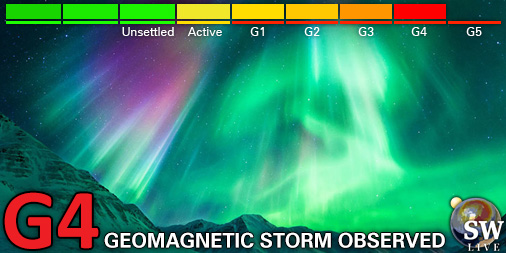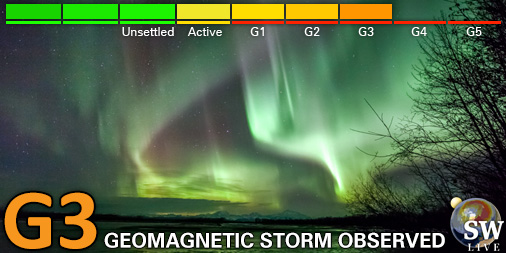Viewing archive of Monday, 29 March 2004
Solar activity report
Any mentioned solar flare in this report has a scaling factor applied by the Space Weather Prediction Center (SWPC). Because of the SWPC scaling factor, solar flares are reported as 42% smaller than for the science quality data. The scaling factor has been removed from our archived solar flare data to reflect the true physical units.
Report of Solar-Geophysical Activity 2004 Mar 29 2200 UTCPrepared by the NOAA © SWPC and processed by SpaceWeatherLive.com
Joint USAF/NOAA Report of Solar and Geophysical Activity
SDF Number 089 Issued at 2200Z on 29 Mar 2004IA. Analysis of Solar Active Regions and Activity from 28-2100Z to 29-2100Z
Solar activity was low. Region 582 (N14E18) produced
several C-class flares today. The largest was a C5/Sf at 1551 UTC.
The region dominates the solar disk in size and complexity and
became more active during the past 24 hours. The region appears to
be growing slowly. The only other region producing flares was 587
(S12E63) which managed to produce two B-class events. All the other
regions on the disk were quiet and stable. A CME was observed by
LASCO off the southwest limb around 0040 UTC, but the lack of
corresponding disk signatures suggests that the source was on the
back side.
IB. Solar Activity Forecast
Solar activity is expected to be
mostly low. There is a chance, however, for an isolated M-class
flare from Region 582 during the next three days (30 March - 1
April).
IIA. Geophysical Activity Summary 28-2100Z to 29-2100Z
The geomagnetic field was mostly quiet to unsettled, although there
was one active period from 0300-0600 UTC. Solar wind data show a
declining high speed stream with velocities slowly decreasing over
the past 24 hours. The interplanetary magnetic field shows weak
fluctuations in Bz, ranging from -3 nT to +3 nT. The greater than 2
MeV electron flux was high during the past 24 hours.
IIB. Geophysical Activity Forecast
The geomagnetic field is
expected to be unsettled with a slight chance for an active period
during the next 24 hours (30 March). Conditions should decline to
quiet to unsettled for the second and third days (31 March - 1
April) as the solar wind returns to nominal conditions.
III. Event Probabilities 30 Mar to 01 Apr
| Class M | 35% | 35% | 35% |
| Class X | 05% | 05% | 05% |
| Proton | 05% | 05% | 05% |
| PCAF | green | ||
IV. Penticton 10.7 cm Flux
Observed 29 Mar 129 Predicted 30 Mar-01 Apr 130/130/135 90 Day Mean 29 Mar 111
V. Geomagnetic A Indices
Observed Afr/Ap 28 Mar 012/017 Estimated Afr/Ap 29 Mar 012/013 Predicted Afr/Ap 30 Mar-01 Apr 012/012-010/008-005/008
VI. Geomagnetic Activity Probabilities 30 Mar to 01 Apr
| A. Middle Latitudes | |||
|---|---|---|---|
| Active | 30% | 25% | 20% |
| Minor storm | 20% | 15% | 10% |
| Major-severe storm | 05% | 05% | 05% |
| B. High Latitudes | |||
|---|---|---|---|
| Active | 30% | 25% | 20% |
| Minor storm | 25% | 20% | 15% |
| Major-severe storm | 10% | 05% | 05% |
All times in UTC
Latest news
Latest forum messages
2025/04/12-13 Filament CMEs 2025/04/16 G3 Watch 476Coronal holes 51Filaments and prominences 67AR4064 9Incoming & Unnumbered Active Regions 1742
More topicsSupport SpaceWeatherLive.com!
A lot of people come to SpaceWeatherLive to follow the Sun's activity or if there is aurora to be seen, but with more traffic comes higher server costs. Consider a donation if you enjoy SpaceWeatherLive so we can keep the website online!

Latest alerts
Wednesday, 16 April 2025
21:45 UTC - Geomagnetic activity
Minor G1 geomagnetic storm (Kp5) Threshold Reached: 21:36 UTC
21:00 UTC - Geomagnetic activity
Severe G4 geomagnetic storm (Kp8) Threshold Reached: 20:55 UTC
19:45 UTC - Geomagnetic activity
Strong G3 geomagnetic storm (Kp7) Threshold Reached: 19:25 UTC
19:00 UTC - Geomagnetic activity
Moderate G2 geomagnetic storm (Kp6) Threshold Reached: 18:38 UTC
18:45 UTC - Geomagnetic activity
Minor G1 geomagnetic storm (Kp5) Threshold Reached: 18:28 UTC
Space weather facts
| Last X-flare | 2025/03/28 | X1.1 |
| Last M-flare | 2025/04/15 | M1.2 |
| Last geomagnetic storm | 2025/04/16 | Kp8- (G4) |
| Spotless days | |
|---|---|
| Last spotless day | 2022/06/08 |
| Monthly mean Sunspot Number | |
|---|---|
| March 2025 | 134.2 -20.4 |
| April 2025 | 120.7 -13.5 |
| Last 30 days | 120.8 -19.6 |







